Zombies draw students, employees into information fair
Passersby startled by the sight of Hollywood monsters stuck around to learn how to be prepared for nearly any emergency.
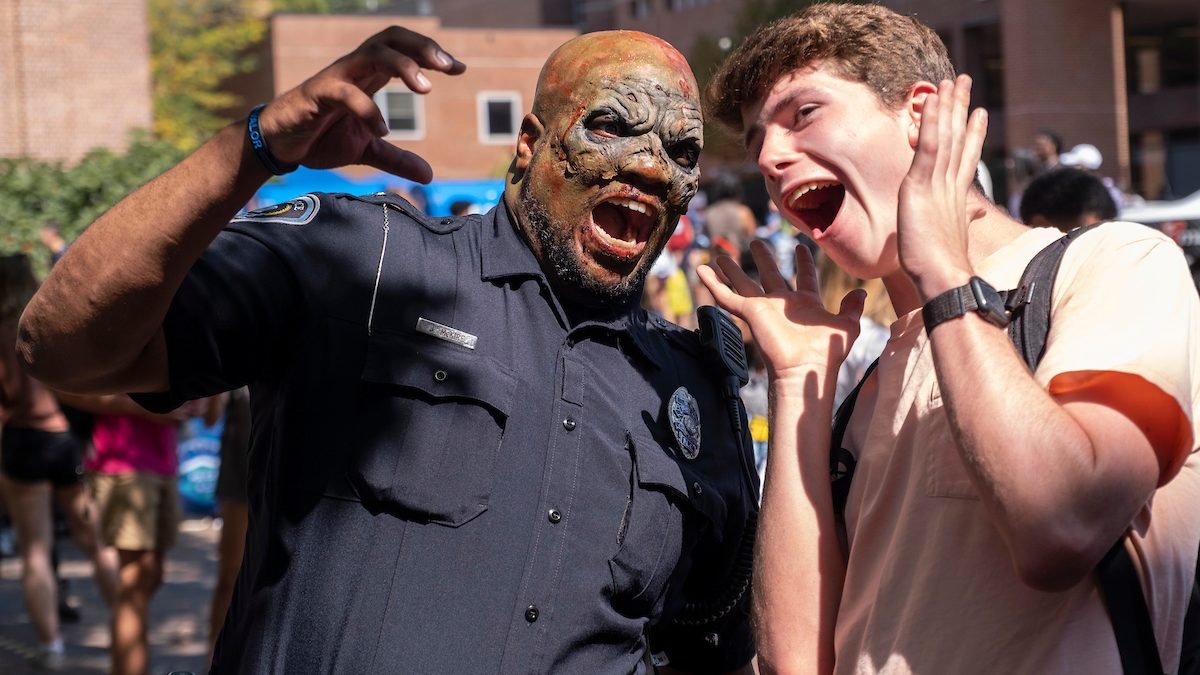
“So it’s like a zombie apocalypse preparedness thingy,” a student standing in the Pit last Thursday said into her phone. All around her, University staff volunteers made up “Walking Dead” style stumbled and lurched through the lunchtime crowd, handing out printed cards with the QR code for the Carolina Ready safety resources site.
Welcome to the 2022 Tar Heel Zombie Preparedness Festival.
Held in conjunction with National Preparedness Month, the event featured 27 safety-related exhibitors and a dozen demonstrations on real-life emergencies at tables and tents set up midday in the Pit, on Polk Place and on the brick courtyard surrounding the Frank Porter Graham Student Union.
Participants munched on “survival poke bowls” whipped up by Carolina Dining Services from emergency supply ingredients or tried to walk a straight line while wearing Chapel Hill Police’s “Fatal Vision” goggles simulating alcohol or drug impairment. They learned how to dress wounds, how to perform CPR, how to pack a go-kit and how to apply pressure or a tourniquet to stop bleeding.
“While we can’t always predict what the next emergency may be, we can prepare. The variety of exhibits and demonstrations by our campus and community partners helped students understand the value of an all-hazards approach to emergency preparedness,” said Darrell Jeter, director of emergency management and planning.
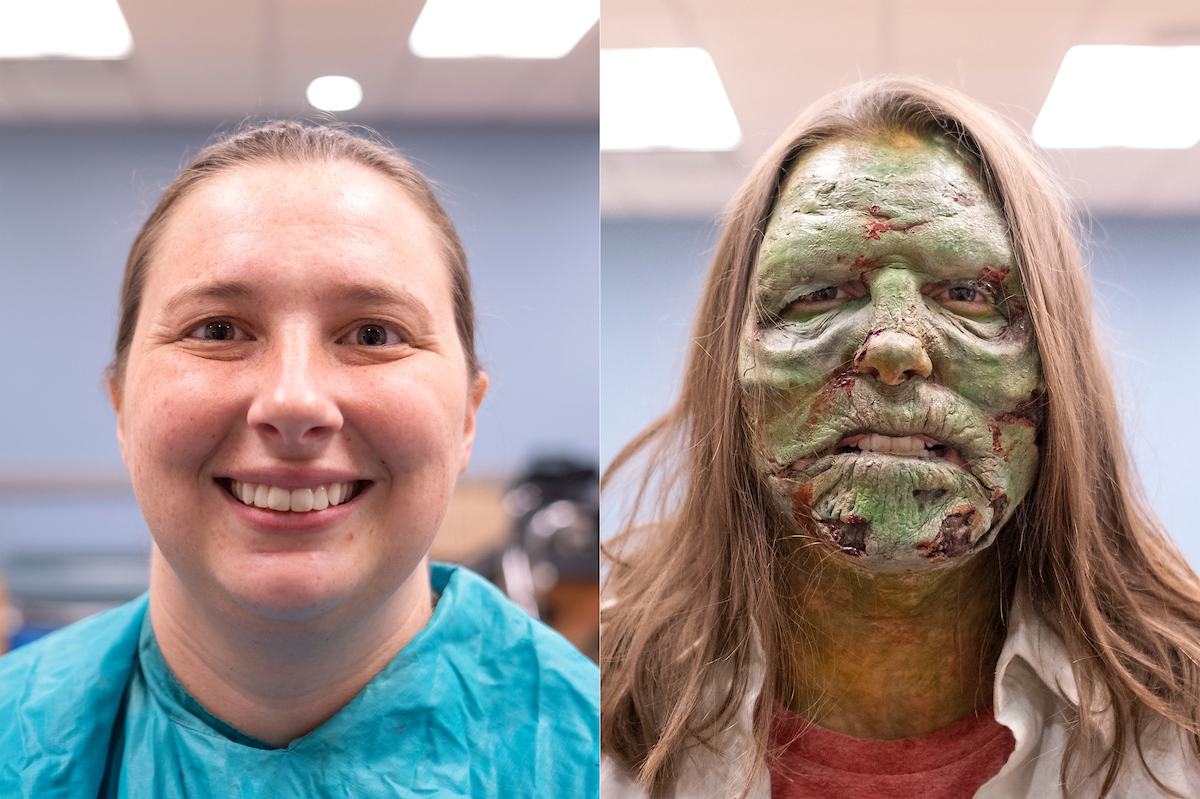
Nathalie Donaghy, an ITS network analyst, before and after her zombie treatment. She is a “hero” zombie, a term used for those made up with enough detail to qualify for a close-up shot in a movie. (Jon Gardiner/UNC-Chapel Hill)
Becoming a zombie
The day began early for several staff members who volunteered to be transformed into Hollywood monsters by professional movie makeup artists Dean and Starr Jones with the application of prosthetics, paint and costumes. Five of the 20 volunteers were “hero” zombies, five had smaller prosthetic “wounds” applied to their faces and the rest chose a mask from a long table of scary heads on display in the Student Union room. Some selected clothing — shirts and jackets with exposed rib cages or sleeves with skeleton arms — from the zombie wardrobe rack.
Starr Jones applied a bony ridge to the forehead of Nathalie Donaghy, an ITS network analyst, using a blow dryer to set the sickly green prosthetic in place. Shades of green are “good for decomposition,” Jones said, dabbing and blending green and brown tints with a brush and a paint palette to disguise the edges of the attachment.
“It’s been my lifelong dream to be a zombie,” said Donaghy, getting into character. “I will be dragging one foot, and there will definitely be some growling.”
In another chair, UNC Police 911 telecommunicator Farrah McKoy waited her turn to be transformed. “It’s a cool idea, and I think it’s good for someone from the (dispatch) center to participate,” she said. McKoy got interested in movie makeup while watching the “Face Off” reality show and said she was “excited and scared at the same time” to be the one getting made up.
In coming up with the backstory for how she became a zombie, McKoy blamed UNC Police officer Jamison McKire, another hero zombie, for leaving the door to the dispatch center open when he rushed out to the first emergency call.
“I want to raise awareness and teach about emergency preparedness,” said McKire, readjusting his police uniform after receiving his own zombie treatment. His makeup included a shotgun wound to the top of his head, painted dark red to simulate blood. “But it’s also an awesome opportunity to become a zombie.”
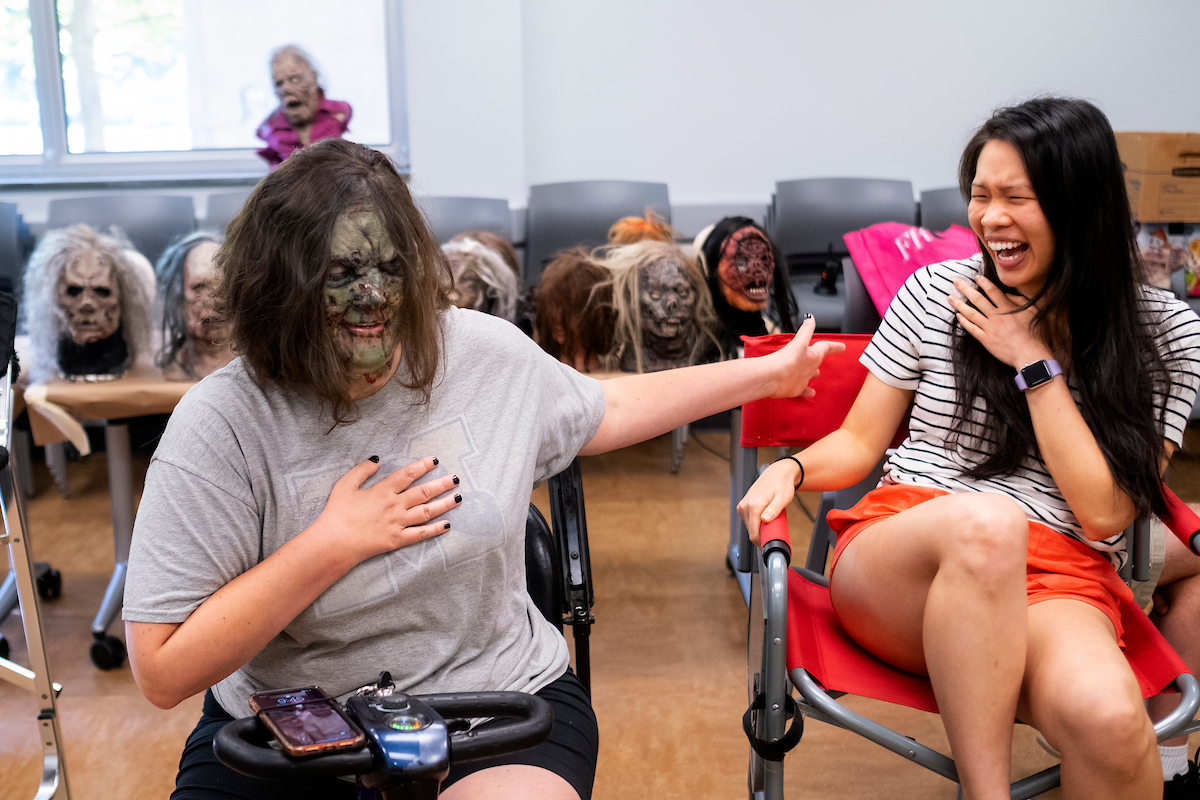
Thao Nghi Tu, right, suddenly realizes that she knows the zombie she’s been talking to (Tiffany Bailey). (Jon Gardiner/UNC-Chapel Hill)
Tiffany Bailey, who works in the University’s Equal Opportunity and Compliance Office, also volunteered for educational and entertainment purposes. “It’s about raising awareness,” she said. “But I love true crime and I love horror, and this is really fun.” Bailey’s ghoulish green face so transformed her appearance that co-worker Thao Nghi Tu, also there to get a flesh wound, talked to her for several minutes without recognizing who she was.
At a safety briefing in the room next door, labeled the Zombie Lounge, organizers reminded volunteers to take frequent breaks and drink plenty of water, since the temperature would climb into the 90s. “We want hydrated and healthy zombies, despite how terrifying some of you may look,” said Justin Miller, emergency management coordinator. “Have fun with it.” And a little after 11 a.m., the 20 zombies and a spookily shrouded Rameses mascot lurched out of the Student Union to terrorize, mildly, the people in the Pit.
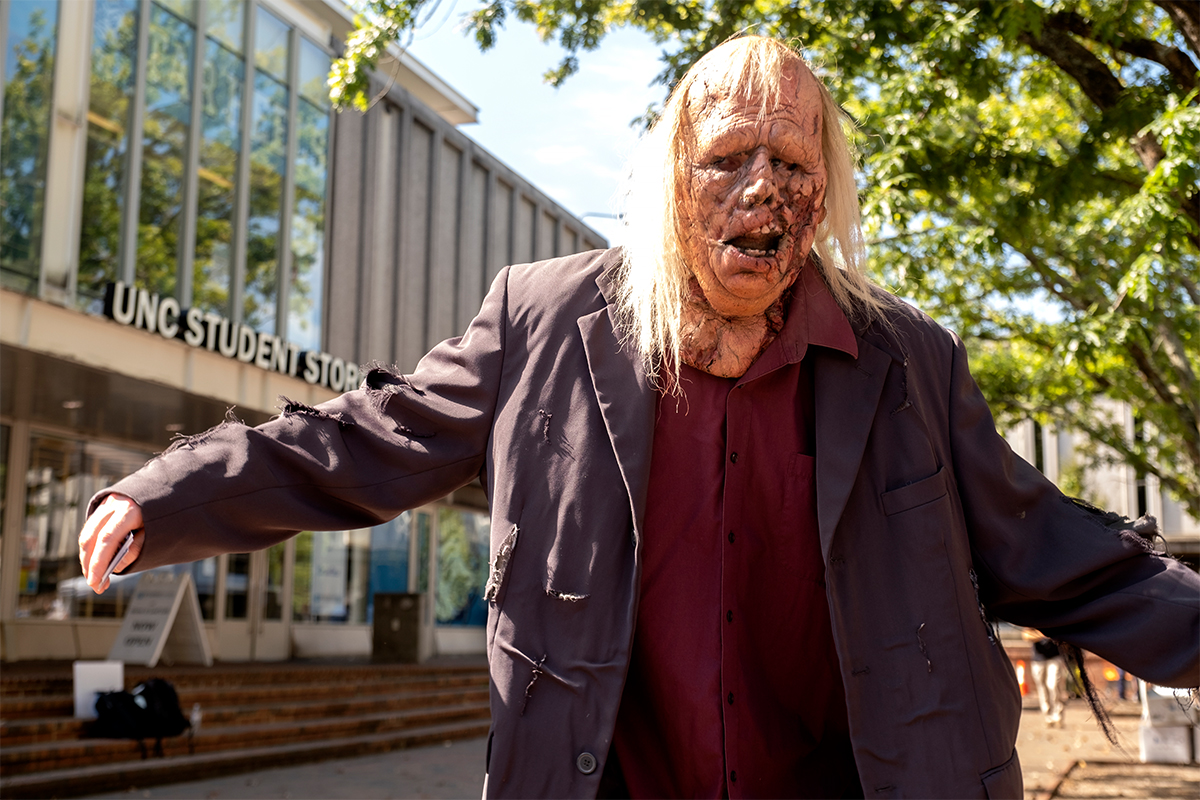
Most of the zombies at the event wore masks like this one. (Jon Gardiner/UNC-Chapel Hill)
The dangers of fire
Zombies aren’t real, but fire danger is, as showcased in two of the most dramatic demonstrations at the preparedness festival. Employees of the University’s Environment, Health and Safety office and the Chapel Hill Fire Department showed how quickly cooking fires can get out of control and let students practice putting them out with a fire extinguisher.
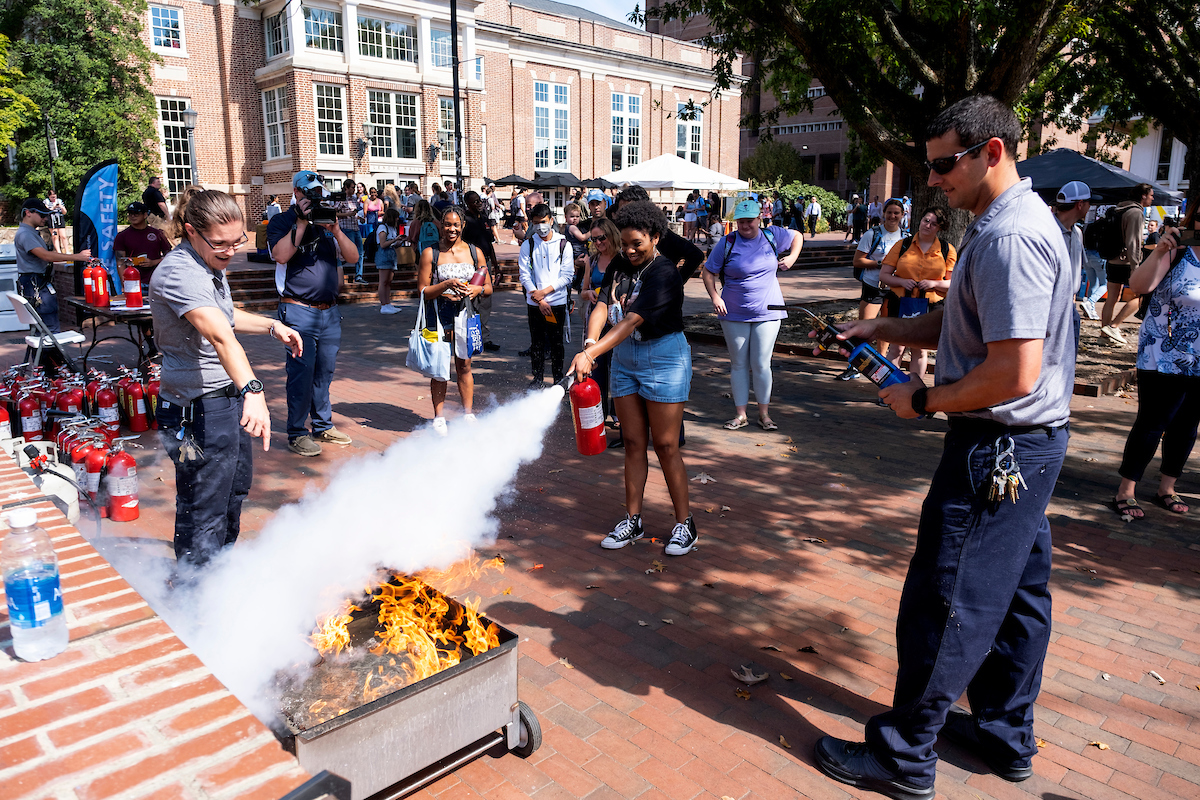
Students learn how to properly extinguish a fire. (Jon Gardiner/UNC-Chapel Hill)
Meanwhile, on Polk Place, a large trailer divided into two simulated Carolina apartments or residence hall rooms — one equipped with sprinklers and one without — parked on the brick sidewalk, waiting to be torched.
“Dude, I swear to God they’re going to light it on fire,” one excited student told his friend on the other end of the phone. “You need to get down here now!”
And officials from the North Carolina Office of State Fire Marshal did just that, using a flare to spark a fire first in the non-sprinkler room, decorated in Carolina blue with a Tar Heel pennant, calendar and stuffed Rameses doll. Wisps of white smoke wafted from the front of the trailer, getting thicker and darker by the second until the room seemed to spontaneously burst into flame. As black smoke billowed from the trailer, the firefighters who had been standing by trained their hoses on the fire and doused the flames.
The man narrating the demo pointed out that, of course, no fire department would ever have been able to reach the fire that quickly in a real-life situation.
Next, they set the room with sprinklers on fire, with the same wispy smoke at first but with sprinklers activated when the first flames appeared. Water cascaded from the ceiling, quickly smothering the fire. When the demo was over, a student walked up to retrieve the Rameses doll, which appeared unharmed.
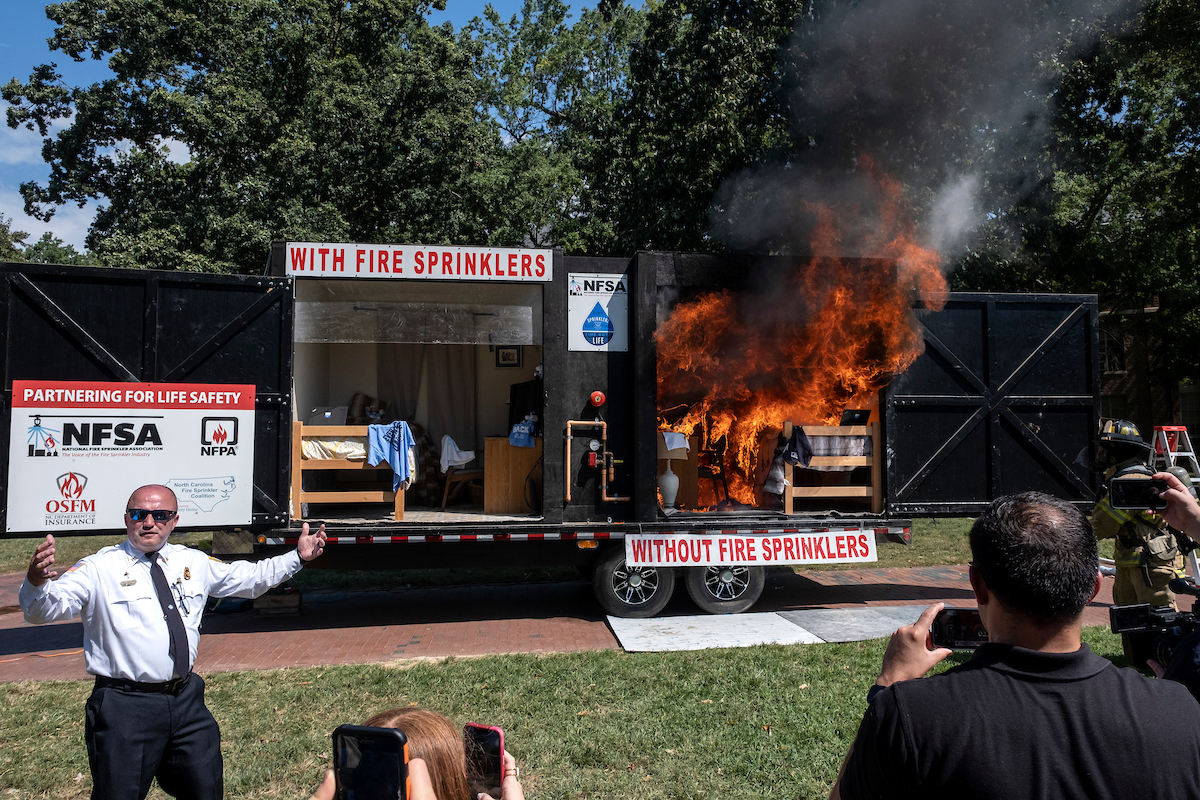
Officials from the North Carolina Office of State Fire Marshal sparked a fire in a simulated residence hall room without sprinklers. (Jon Gardiner/UNC-Chapel Hill)




